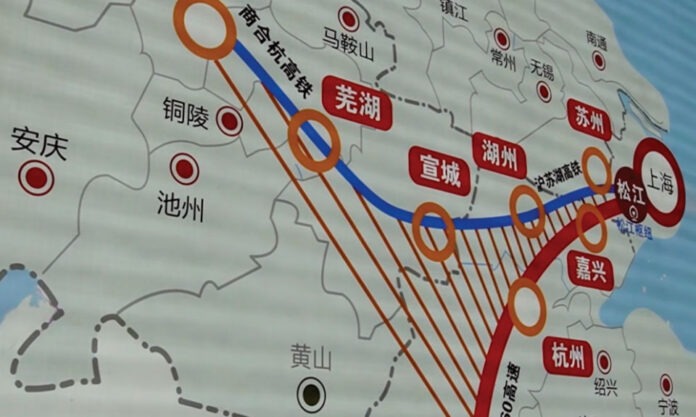Something is immediately apparent upon crossing the border from Jiangsu into Zhejiang Province. A sudden deterioration in quality of road surface.
And that happens at the border’s toll gate, where the Jiangsu government collects a slice of cash from every driver passing through. For as local parlance has it, the Jiangsu government is loaded, but Zhejiang’s not; the people in Jiangsu are poor, but Zhejiang’s stinking rich.
But nothing like that can be said of the Lake Tai Ring Road. Recently listed as an Outstanding Transportation Industry Case in the Yangtze River Delta and assessed as one of the ten most beautiful roads in China, the recently completed project is the first highway in the country to be realised via a full cooperation between two provinces.
It, along with Suzhou’s Metro line 11, linking up with Shanghai, that is also the country’s first cross border urban-transit connection, is one of the most visible manifestations of a concept that has been taking root over the past 5 years, that of Yangtze River Delta Integration (YRDI).
First proposed by Secretary of CPC Jiangsu Committee Lou Qinjian in 2019, the interim has seen a host of initiatives come to fruition across multiple sectors. These have brought tangible benefits to the lives of people living and working in the region and also helped the Delta to maintain its position as the most economically active spot on the planet.
Such a push for interconnectivity is well illustrated in the field of air cargo. 12 March was the date when the two airport groups representing Nanjing Lukou and Wuxi Shuofang made public the “Strategic Cooperation Agreement on Collaborative Development of International Air Freight” signed together with Nanjing Airport Economic Demonstration Zone and Wuxi Municipal Transportation Bureau.
The Agreement will, in theory, make possible information sharing, route coordination, cargo customs clearance, warehousing and logistics, and enterprise cooperation between the two airports.
With Nanjing Lukou and Wuxi Shuofang handling a total cargo volume of of 383,500 and 126,000 tonnes, respectively, last year, that translates to our online orders arriving at our doorstep even faster than they do today, and from further away.
Elsewhere, that YRDI also seeks to bring about greater productivity is perhaps best illustrated by the G60 Science & Technology Corridor, named after the expressway that links Shanghai with Kunming in faraway Yunnan Province. Its catchphrase can be thought of as “combination, not duplication”.
Looking to the robotics industry as an example, the G60 Science & Technology Corridor has brought about the Robotics Industry Alliance, whereby nine cities may leverage their industrial advantages. The city of Wuhu in Anhui, for example, has a reputation for articulated robotics, mobile industrial robots are a specialty of Hangzhou in Zhejiang, while many of the key components for robots are manufactured in Suzhou. YRDI means each can support each other, avoid unnecessary competition and reduce overall project redundancy.
It all amounts to a dissolution of borders between provinces. And that’s great news for the environment which knows of no such concept.
Fen Lake is poster child. With the Taipu River running through it on its way to Shanghai and straddling both Jiangsu and Zhejiang, the Chinese name of the Lake, appropriately, means “division”.
But it also meant all the authorities involved had a habit of passing the buck when it came to environmental protection, which was bad news as the Lake was in recent years gripped by a mass proliferation of hyacinths. With no one willing to take responsibility, the hyacinths were left unchecked to clog the waterways.
Under the YRDI was therefore launched the “Joint River Chief System” by Wujiang District of Jiangsu, Jiashan County of Zhejiang and Qingpu District of Shanghai. The results yielded by the initiative mean that the hyacinths now account for just 10 percent of Fen Lake’s surface area.
Still with geography, Jiangsu province has long suffered from regional economic disparities; the rich cities south of the Yangtze River often viewing their poorer northern cousins as backward. Hence, what is needed is something by way of a financial kick around between the two.
It therefore came to be that on 14 March, the Wuxi Lianyungang Specialised New Industrial Park with a total investment of approximately ¥3.5 billion saw construction begin, with its first phase to occupy an area of 5.7 hectares.
The two cities were taking a leaf out of the book written by Suzhou and Suqian back in 2019. Up north there, the Suqian Suzhou Industrial Park has seen 25 projects introduced from down south, with a planned total investment of over ¥20 billion. And that’s Yangtze River Delta Integration in operation.









